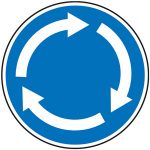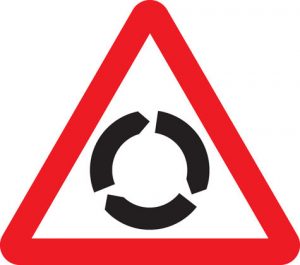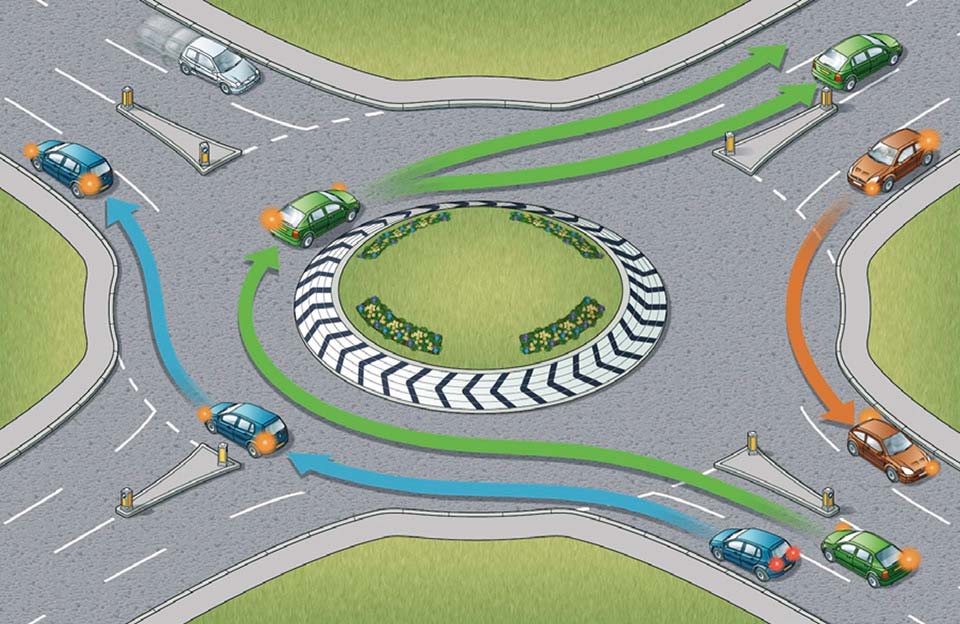Roundabouts are a type of junction where, in the UK, road traffic flows clockwise around a central junction, with priority normally given to those already on the roundabout and those approaching it on your right. They are designed to keep the traffic flowing safely without the need for traffic lights. In this article we give you the low-down on all the different roundabouts you will come up against and how to use them safely.

General Roundabout Rules
Roundabouts are indicated by a triangular sign with a red border and three arrows pointing in a clockwise direction and forming a circle, as seen below.
Usually, traffic approaching the roundabout gives way to traffic which is approaching from the right by stopping at a ‘Give Way’ marking. However, if you can see that it is safe to emerge as you approach, then you should not stop at the roundabout to help keep the traffic flowing.
There are two scenarios whereby the usual priorities are redefined:
- On-Road Markings – There are some instances when traffic approaching from the right has to give way to traffic entering the roundabout (who would usually give way to them). This is indicated by on-road markings on the roundabout itself so make sure to look out for these.
- Traffic Lights – Some roundabouts use traffic lights to determine priority. This is often the case on larger or busier roundabouts. You should also watch out for roundabouts which use traffic lights only at peak times (and the usual priority at off-peak times).
Always make sure to use the mirrors, signal, manoeuvre routine as you approach a roundabout and adapt your position and speed accordingly based on what you are able to see on your approach to the roundabout. You will need to check the appropriate mirrors, use the correct indicator, and move into the correct position in relation to the exit you plan to take.
Taking the First Exit Left at a Roundabout (Orange Car)
| When? | Routine | Linked Action (for 1st left Exit) |
| On Your Approach | Mirrors | Check your left and interior mirrors |
| Signal | Indicate left as you approach | |
| Manoeuvre | Stay in the leftmost lane | |
| Speed | Stay in the gear you are in to slow down. If the traffic appears to be flowing well, move into second gear as you might be able to enter the roundabout without stopping. However, be prepared to brake and stop if there is a queue. Move off in first gear if stopped. | |
| Look | As you approach the roundabout, look to your right to see if you can enter without stopping. | |
| On the Roundabout | Position | Stay in the left lane of the roundabout |
| Look | As you emerge onto the roundabout make sure to look ahead to ensure you do not drive into the back of a car that may have stopped on the roundabout. | |
| Manoeuvre | Immediately exit the roundabout in the left lane. |
Going Ahead at a Roundabout (Blue Car)
| When? | Routine | Linked Action (for 1st left Exit) |
| On Your Approach | Mirrors | Check your left and interior mirrors |
| Signal | There is no need to signal | |
| Manoeuvre | Stay in the leftmost lane UNLESS the road markings tell you otherwise | |
| Speed | As above, slow down and take second gear if the traffic is flowing well, but be prepared to stop if there is a queue and make sure to move into first gear to move off again. | |
| Look | Look to your right to see if you can enter without stopping. | |
| On the Roundabout | Position | Stay in the left lane (or the lane you approached in as marked on the road) |
| Look | Look ahead as you emerge to ensure you do not drive into a car on the roundabout | |
| Mirrors | Check your interior and left mirrors | |
| Signal | Indicate left once you have passed the exit before the exit you intend to leave by to warn other road users you are planning to leave the roundabout. | |
| Manoeuvre | Exit the roundabout in the left lane. |
Turning Right at a Roundabout (Green Car)
| When? | Routine | Linked Action (for 1st left Exit) |
| On Your Approach | Mirrors | Check your interior and right mirrors |
| Signal | Indicate to the right | |
| Manoeuvre | Move into the right-hand lane. If there are two lanes or more marked with a right arrow choose the most appropriate lane for your destination based on how far round to the right your exit is. | |
| Speed | As above, slow down and take second gear if the traffic is flowing well, but be prepared to stop if there is a queue and make sure to move into first gear to move off again. | |
| Look | Look to your right to see if you can enter without stopping. | |
| On the Roundabout | Position | Maintain your position in the right-hand lane (or the lane you approached in as marked on the road) |
| Look | Look ahead as you emerge to ensure you do not drive into a car on the roundabout | |
| Mirrors | Check your left and interior mirrors | |
| Signal | Indicate left once you have passed the exit before the exit you intend to leave by to warn other road users you are planning to leave the roundabout. | |
| Manoeuvre | Exit the roundabout in the furthest left lane that is possible. If someone is in the lane next to you, you should take the next furthest left lane possible. |
Large Multi-Lane Roundabouts

You should use the MSMPSL (Mirrors, Signal, Manoeuvre, Position, Speed, Look) routine on approach to these roundabouts. When a roundabout has more than three lanes there will usually be road signs and markings to help you select the right lane to move into and maintain once you are on the roundabout. Always try and choose the most appropriate lane for your destination that you can move into safely. Make sure you move into the right lane in good time and stay in the lane you have chosen once on the roundabout.
The markings will bring you nearer to the left of the roundabout after each exit you pass. This helps you to exit the roundabout safely. Be aware that on large roundabouts your lane can split into two. You should take the left lane of any split unless you need to be in the right-hand lane unless you plan to turn right off the road your exit on to or are moving past a slow-moving vehicle occupying the left lane. Always use the MSM routine to exit a roundabout regardless of its size.
Mini Roundabouts

 As mini roundabouts are not always visible on the road as you approach them there will usually be a sign indicating where one is. The sign is blue with 3 arrows pointing in a clockwise direction and forming a circle, as seen below.
As mini roundabouts are not always visible on the road as you approach them there will usually be a sign indicating where one is. The sign is blue with 3 arrows pointing in a clockwise direction and forming a circle, as seen below.




